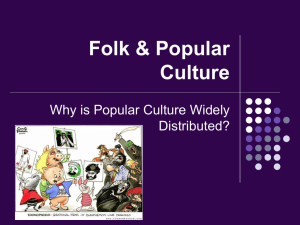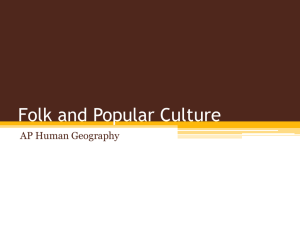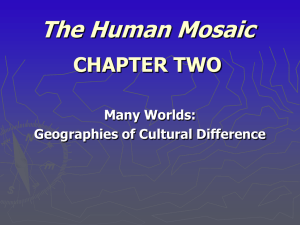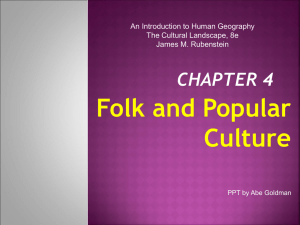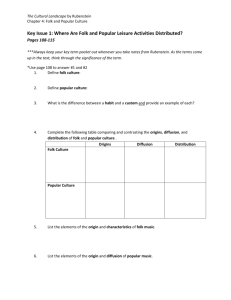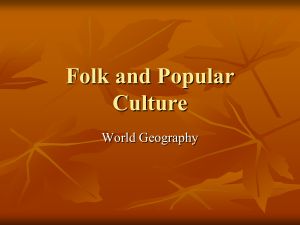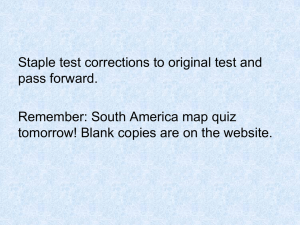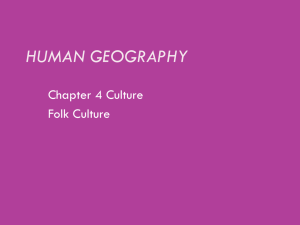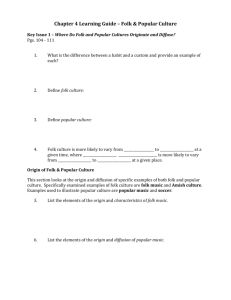Chapter 4 Learning Guide – Folk & Popular Culture
advertisement
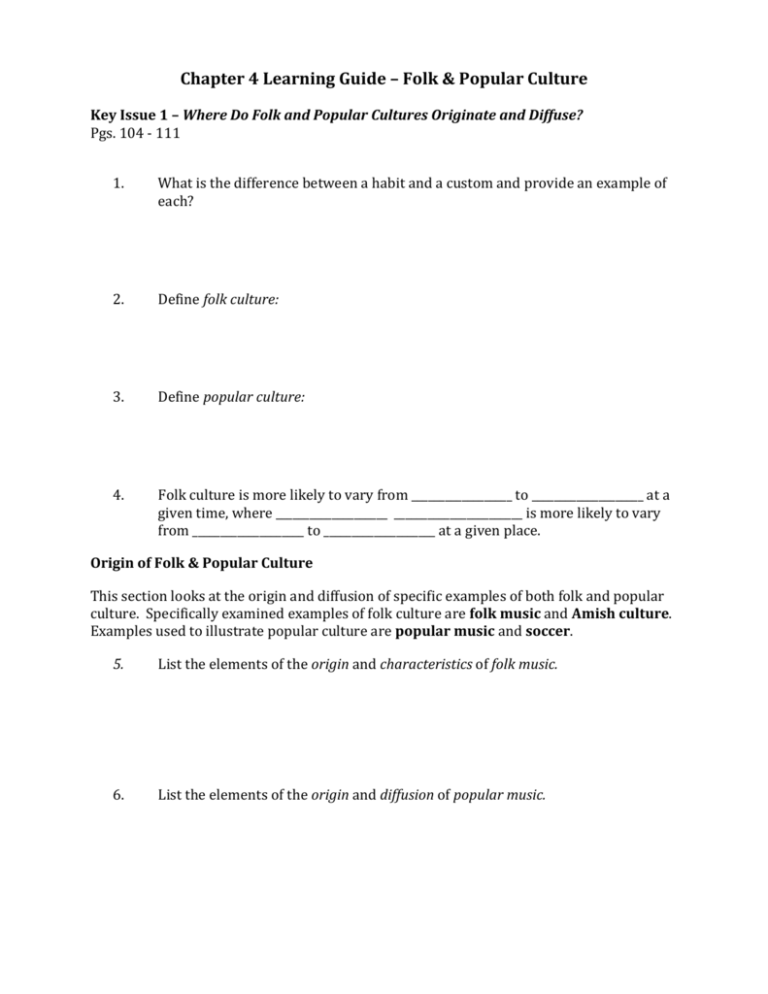
Chapter 4 Learning Guide – Folk & Popular Culture Key Issue 1 – Where Do Folk and Popular Cultures Originate and Diffuse? Pgs. 104 - 111 1. What is the difference between a habit and a custom and provide an example of each? 2. Define folk culture: 3. Define popular culture: 4. Folk culture is more likely to vary from __________________ to ____________________ at a given time, where ____________________ _______________________ is more likely to vary from ____________________ to ____________________ at a given place. Origin of Folk & Popular Culture This section looks at the origin and diffusion of specific examples of both folk and popular culture. Specifically examined examples of folk culture are folk music and Amish culture. Examples used to illustrate popular culture are popular music and soccer. 5. List the elements of the origin and characteristics of folk music. 6. List the elements of the origin and diffusion of popular music. 7. Shade and label the hearths of today’s Hip Hop music in the U.S. and label the location of the origin with a dot. Diffusion of Folk & Popular Culture 8. Where did Amish culture originate, and how did it diffuse to the United States? 9. In what ways is Amish culture distinct from the popular culture of the United States? 10. What is happening to the Amish in the United States today? 11. Label and shade the areas of larger Amish settlements in the U.S. 12. How was soccer transformed from a folk custom into popular culture? 13. Despite their anonymous folk origins, what characteristics of organized spectator sports today characterize them as popular culture? 14. Label popular sports with the countries in which they are most popular and with which they are best associated. Chapter 4 Learning Guide – Folk & Popular Culture Key Issue 2 – Why is Folk Culture Clustered? Pgs. 111 – 117 Influence of the Physical Environment 1. How does clothing style (in this case shoes) indicate the influence of the environment on folk culture? 2. List 3 different examples of food habits and the unique folk cultures each illustrates. 3. Indicate some food taboos, along with the cultures that practice them, in the chart below. Food Taboos Cultures/Regions Foods/Reasons 4. In what sense are building materials of folk housing unique? Isolation Promotes Cultural Diversity 5. Summarize how cultural diversity in the Himalayas is displayed in local art. 6. What cultural institution is shaping these differences? 7. What environmental conditions (which are the same for all groups here) are NOT ensuring similar art forms in this case? 8. Fred Kniffen, a cultural geographer, has identified three source regions for American folk housing styles: New England, Middle Atlantic and Lower Chesapeake. List the housing styles he identified with each region. New England (4 styles) – Middle Atlantic (1 dominant style) – Lower Chesapeake – Chapter 4 Learning Guide – Folk & Popular Culture Key Issue 3 – Why is Popular Culture Widely Distributed? Pgs. 117 – 125 1. In contrast to folk customs, popular customs diffuse ___________________ across the Earth’s surface to location with a wide variety of ________________ ________________. This diffusion depends, however, upon a group of people having a sufficiently high level of ___________________ _______________________ in order to obtain the ______________________ ___________________ associated with the popular custom. Diffusion of Popular Housing, Clothing & Food 2. Consumption of large quantities of what two food products are characteristic of popular culture? 3. How is each of these food preferences expressed regionally, according to culture? 4. In Western countries where popular culture predominates, clothing styles generally reflect ________________ rather than particular ________________________. 5. What are 3 facts about clothing styles associated with popular culture? 6. ________________ are an important symbol of the _____________________ of Western ______________________ _____________________. 7. Complete the chart below to indicate the decade(s) during which each housing style was dominant and a fact about the particular style of house. Style Minimal Traditional Decades(s) Facts Ranch House Split-Level Contemporary Style Shed Style 8. What are the Neo-eclectic styles of the 1960’s and 1970’s? Electronic Diffusion of Popular Culture 9. Give 2 reasons for which television is an especially significant element of culture. 10. Complete the chart with countries/regions using the bottom map on pg 123. Television is Universal Television is Common Television is Rare Using the bottom map on pg 124, answer #11 – 13. 11. Currently, where is the Internet most widely available? 12. In what regions will it most likely continue to grow? 13. What regions, then, does that leave as still relatively untouched by the Internet, in the foreseeable future? Chapter 4 Learning Guide – Folk & Popular Culture Key Issue 4 – Why Does Globalization of Popular Culture Cause Problems? Pgs. 125 – 130 Threat to Folk Culture 1. How and where has folk clothing styles worldwide been threatened by popular culture? 2. How have women in many parts of the world been helped by the spread of popular culture? How have they been hurt? 3. What 3 countries dominate worldwide television markets? What regions does each dominate? Country dominating television… Region it dominates… 4. Why do developing nations view television as a new source of cultural imperialism? 5. What are the world’s two largest newspaper organizations? What countries are they associated with? 6. In many parts of the world, what is the only reliable and unbiased source of news information? Environmental Impact of Popular Culture 7. How is the playing of golf and golf courses an example of a popular custom that is not generally in harmony with the local environment? 8. What is a uniform landscape? 9. How and why is this concept utilized by fast-food restaurants? 10. What are the two ways in which popular customs have an adverse effect on the natural environment?

